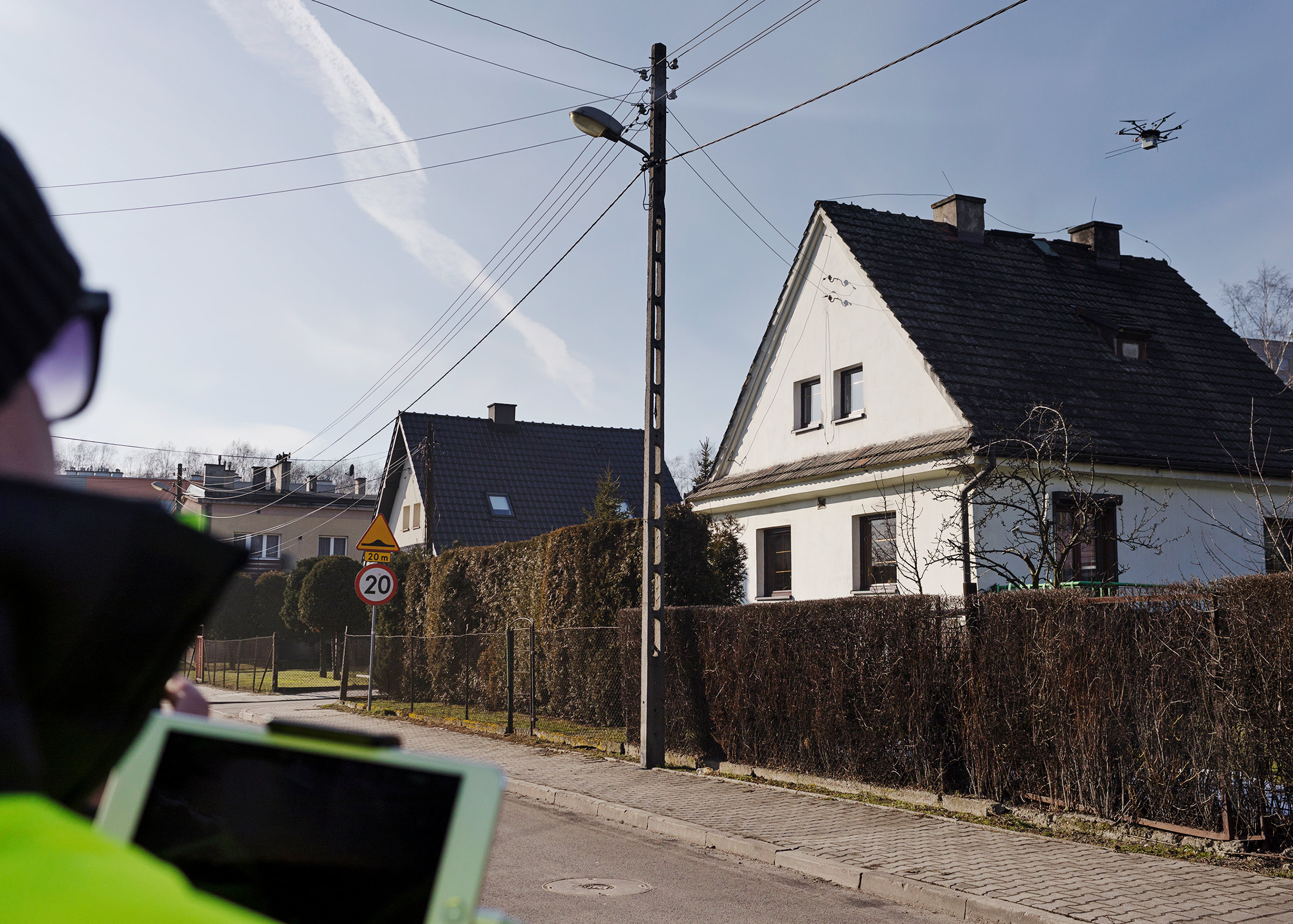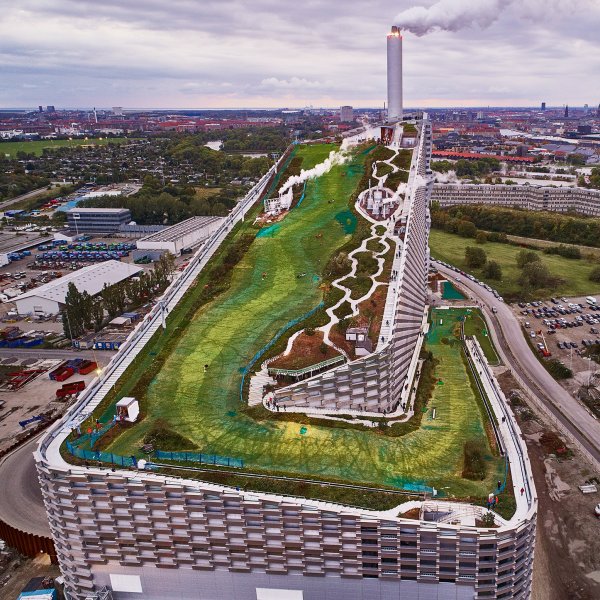It’s winter in The south of Poland, but the ground is clear of any snow, and the thick clouds don’t carry any precipitation. Instead, the skies have been darkened by a layer of smog. The culprit is coal, and if there was any doubt, it would be dispelled by the 50-mile drive across the countryside from historic Krakow to the industrial city of Katowice. Lining the highway, there are the coal-processing facilities, where the rock is cleaned and prepared for use. Smokestacks jut into the sky, marking the country’s coal-fired power plants. Even the homes, visible from the highway, have a faint gray-colored exhaust, the result of the coal being used for heat.
The pollution is a blight; Katowice ranks among the most polluted cities in Europe, and locals complain about the low air quality. But even so, many here aren’t ready to let go of the natural resource that has powered the nation’s economy since the Industrial Revolution. Culture in Katowice—and in smaller cities and towns in the surrounding province of Silesia—developed around the mines, from the soccer clubs sponsored by the mining companies to the local festivals they supported. Strikes at Silesian coal mines played a key role in the uprising that brought democracy to Poland in the 1980s. Today, the mines still occupy a place of reverence to many of the region’s residents. A 131-ft. former mine-shaft tower sits near the city center, and at the adjacent Silesian Museum, visitors can walk away with souvenir coal paraphernalia. “People may not like it, but they also need to acknowledge the good side,” says former underground coal miner Marek Wystyrk over coffee in Katowice when TIME visited in December 2018. “It’s not all evil.”
Katowice, with a population around 300,000, may seem like an odd place to look to understand the future of the European Union. But as the E.U. seeks to turn its recovery from the coronavirus pandemic into a moment to pivot to a greener future, this city and myriad others built upon a fossil-fuel economy face a reckoning. The E.U. actually began as an alliance around coal and steel production. But that was 70 years ago, and now the union is attempting to unite against the threat of climate change.
The plan is simple yet bold. In December, the E.U. outlined plans to spend what would total €1 trillion ($1.17 trillion) on a “Green Deal” aimed at eliminating the bloc’s carbon footprint by 2050 and refashioning the economy around new, low-carbon industries. The investment, originally meant to be funded through the E.U. budget, private-sector financing and other country contributions, includes everything from retrofitting buildings to scaling up the infrastructure necessary for electric vehicles to investing in hydrogen-energy storage. After the pandemic struck, the E.U. structured its COVID-19 recovery package around accelerating the plan. “We need to change how we treat nature, how we produce and consume, live and work, eat and heat, travel and transport,” said Ursula von der Leyen, president of the European Commission, the E.U.’s executive body, in a September speech.
Bold moves to address climate change are broadly popular—polling has shown more than 90% of E.U. citizens support aggressive action on climate change—but any serious measure to tackle the issue faces one big challenge: the many regions and industries across the Continent that remain reliant on heavy industry and fossil fuels. So officials in Brussels crafted a so-called Just Transition plan to direct some €150 billion ($177 billion) to the regions most vulnerable to a move away from fossil fuels. The money is intended to act both as a catalyst for these regions to adapt and as an insurance policy to make sure the climate agenda maintains broad popular support. The Green Deal broadly—and Just Transition specifically—are altering the politics of climate change in Europe and the nature of the bloc’s economic development. It might determine the jobs and industries that employ workers across the Continent for the next century. In Poland, the Green Deal has already fueled a rush to chart a new path, one that honors the country’s coal-mining heritage while also preparing it for a new future. In September, the country committed to shutting down its coal mines for good. The question now is how to do that, and whether the country can move fast enough to meet the E.U.’s deadlines. “We are at a key, critical moment in the history of Poland and in the making of the European Green Deal,” says Michal Kurtyka, Poland’s Climate Minister.
The stakes may be just as high abroad. From Kentucky to South Australia, Ukraine to Indonesia, coal communities around the world are watching closely, looking for models of a successful transition. More important, because the E.U. is the world’s second largest economy and second largest market, the Green Deal will ripple across the world, igniting the global race to develop a clean-energy economy. “It is an invitation for cooperation—with China, India, the United States, Canada,” says Karsten Sach, deputy director-general of the German Environment Ministry.
But for the invitation to work, the miners in Katowice will have to be on board.
The popular image of a coal miner is easy enough to picture: a large, hard-hatted man, dressed in a soiled uniform with a face darkened by the black rock he spends all day extracting. Marek Wystyrk couldn’t have looked more different: bespectacled and neatly dressed, he would look more in place in a library than deep underground. We meet in a café in a stately prewar office building in downtown Katowice.

Wystyrk, who spent nearly 20 years in the underground mines, first as a miner and then as a manager, is full of what seem like contradictions. Speaking through a translator, he praises coal, but he doesn’t say he wants his kids to join the industry. He says something needs to be done about climate change, but doesn’t think it should be Poland’s responsibility to address it. He touts his region’s coal-mining heritage, but he decries how it has left so many behind. It’s a nuanced view—like those of so many on the ground—that’s rooted in an effort to grapple simultaneously with two dueling realities: coal has provided for millions of Polish families, and climate change and the transition away from fossil fuels will, sooner or later, kill the industry. “I would like to defend the good name of mining,” he says. “It’s not just environmental degradation.”
Indeed, coal has given Poland a lot: the fuel for the country’s economic development for the past 150 years. Demand for the natural resource in Europe helped build Poland’s railroads and grow cities surrounding mines, and the rock became a symbol of prosperity and a strong work ethic. After World War II, Poland nationalized the mines in line with its shift to a communist economic system and helped power the entire Soviet bloc.
On the other side of the Iron Curtain, Western European countries sought new ways to collaborate and protect their common interests, and coal played a central role. In 1952, six European countries formed the European Coal and Steel Community. The organization, which would evolve into the 27-member European Union, was founded on the principle that a common market for coal and steel—essential to the economy of any industrialized nation—would eliminate the risk of another intra-European conflict and create a new foundation for economic development.
This alliance grew in significance over the following decades, especially as the Eastern bloc of communists eroded in the 1980s and 1990s. (In Poland, that transition came about in part because of strikes that ground the country’s economy to a halt in 1988, including at coal mines.) With time, the E.U. came to regulate the agricultural sector and make environmental policy. The central European government pushed its members to espouse democratic values and rewarded them with investments from its central budget. Poland joined in 2004, after adopting a market economy and becoming a democracy.
But since the very beginning, tensions have existed between richer and poorer countries in the union over everything from fiscal policy to defense and migration. The need to respond to climate change is no different, especially as it’s the poorer, largely Central and Eastern European nations whose economies depend more on heavy-polluting industry.
The Green Deal was born out of all those challenges. A new economy, European leaders hope, will lead to a revived and more integrated Continent. “The European Green Deal is Europe’s new growth strategy,” said von der Leyen before she presented the program in December. “It will cut emissions while also creating jobs and improving our quality of life.”
At first, Poland rejected the plan’s ambitions. President Andrzej Duda had promised to save the coal industry and its jobs—part of a controversial populist appeal to national identity and heritage. “As long as I am the President,” he said in 2018, “I won’t allow for anyone to murder Polish mining.” For months, Duda’s government opposed the bloc’s 2050 carbon-neutrality target, the only E.U. country to do so.
Then the coronavirus pandemic hit. Rather than slow down the process, leaders in Brussels saw an opportunity to expedite their plans. The E.U. Commission—the bloc’s executive body—promised to pour hundreds of billions of euros into the economy in response to the virus and the subsequent lockdowns that halted economies across the Continent. A quarter of the €750 billion recovery plan would be directed toward low-carbon investments; the remainder of the funds came with a “do no harm” provision, meaning the investment shouldn’t be used on projects that harm the environment. And, to keep up the momentum, E.U. leadership promised to spend that proportion of the bloc’s budget on green measures over the next seven years.
Polish leaders in Warsaw faced a conundrum: the government remained rhetorically committed to coal, but the economics had become increasingly difficult. Until the coronavirus plunged the world into global recession, Poland had experienced three decades of sustained economic expansion. But the country would need to rethink its economy to return to growth. As electricity demand plummeted, caused by the pandemic and subsequent lockdowns, coal mines shuttered with difficult economic headwinds anticipated ahead even when the pandemic eases. And leaders in Brussels demanded that the country commit to net zero to be eligible for all of its allocated money under the Just Transition program.
So, slowly, Poland changed its tone. In late July, after months of foot dragging, Polish leaders signed on to the package. The deal would allow Poland to receive half of its allocated Just Transition money even if it didn’t commit to eliminating its carbon footprint. Polish Prime Minister Mateusz Morawiecki hailed it as a victory: “We won,” he said. But it was also a major concession to the E.U.: Poland accepted that it would lose out on billions of euros unless it quickly changed course.
With that money on the line, the pressure has only grown. In September, the country achieved a break-through when it committed to close its mines by 2049, and suggested a willingness to consider the bigger promise to green its economy—with the right conditions. “We are not saying it’s impossible, but we are saying let’s make sure we all exactly know how it’s going to happen,” says Kurtyka, the Climate Minister. “We cannot say in the office in Brussels or in Warsaw: ‘That will be the objective,’ and move on.”
In Poland, discussions have begun from the bottom up. Rather than faceless bureaucrats sending down orders, plans for the energy transition from fossil fuels are being developed with the support and guidance of local communities—the people most likely to be affected by the change.
In the west-central region of Wielkopolska, for example, the E.U. estimates that 6,000 jobs in coal are threatened by the move away from fossil fuels. Maciej Sytek heads the regional authority charged with restructuring the local economy. His mandate is huge. He arranges regular meetings that incorporate labor unions, local government authorities and NGOs. The subcommittees are devoted not just to topics like the economic or energy implications of the transition but also to factors like “social affairs” and “social infrastructure”—a recognition of the cultural challenges inherent in ending a local industry.

Locals here are largely sold on the initiative already. They opposed plans to open new coal-mining territory when the current mines are depleted, and a local mine owner has even opted to train his employees to work in the solar industry. (The largest Polish solar farm is scheduled to open soon in Wielkopolska.) Meanwhile, Sytek is working to attract a range of new industries. E.U. funding is critical to making it happen. “Sometimes you have to just honestly tell yourself that you need to change and start building something new,” he says. But “it’s crucial that the people who lose their jobs are given a new identity, are given hope.” One model for progress can be found across the border in Germany, where as of 2018 some 32,000 people were directly employed in the coal-mining industry. The German government launched a commission to study how to phase out the energy source in 2018. In coal-mining regions across the country, local leaders met with the commission and crafted regional priorities to be collated into one national plan that passed the German Parliament in July. “We were able to agree on big transformative policy in a rather peaceful way,” says the German Environment Ministry’s Sach.
The coronavirus pandemic hasn’t changed the country’s road map, but it has changed the timeline. “We need to undertake investments, which otherwise would be staggered in the next 10 to 15 years, within the next three to five years,” says Sach.
Change is not equally welcome everywhere, however. Silesia, the Polish region where Katowice is located, poses perhaps the most difficult challenge for transition in the entire E.U. The coal sector employs some 73,000 workers there, and many in the region remain hesitant to give up the industry that for decades formed the backbone of their society. Today, locals sadly recall the restructuring of the mines in the 1990s after the fall of the communist regime. That transition resulted in more efficient mines but left hundreds of thousands of people out of work. “In the small towns, if you close down a mine, you will experience a quick social degradation,” says Wystyrk, referring to the 1990s in Silesia.
That’s not to say the efforts there haven’t started. Even before the advent of the Green Deal, local development authorities had begun planning for an energy transition. Since at least 2018, local leaders have engaged in conferences and dialogues on the topic, crafting plans to drive new investment and improve the quality of life. A breakthrough came in September when Silesian coal-mining unions endorsed the plan to end coal mining by 2049. Still, many see that date as too far in the future to align with the
E.U.’s target and argue that the region still needs a plan to end those jobs within a reasonable time frame. Local trade unions remain skeptical that the disruption to jobs and livelihoods can be overcome with a quicker transition. “Sometimes local authorities are even weaker than the trade unions,” says Joanna Mackowiak-Pandera, who heads Polish energy think tank Forum Energii.
So the European leadership in Brussels is pulling out all the stops to convince this corner of the Continent that progress will not leave it behind, economically. The European Economic Congress, an important business summit, convened in Katowice in September, bringing some of the biggest companies and the most important policymakers to debate the future of Europe in the heart of Poland’s coal country. Frans Timmermans, the E.U.’s Green Deal czar, made the importance of the city to the bloc’s energy transition explicit in a speech. “We will have to roll up our sleeves to make sure that this transition is socially fair,” he said. “And there is no other region in Europe today where Just Transition is more important than in Silesia.”
West Virginia and Silesia may be 4,500 miles apart, but there’s a lot they could learn from each other. Just after President Trump took office in 2017, I traveled to West Virginia, the heart of U.S. coal country, to talk to locals about the future of the industry. Virtually everyone I interviewed knew the industry was in trouble and understood the reasons why. Yet they enthusiastically preferred Trump, who promised that he would miraculously “make coal great again” and restore the industry, over Hillary Clinton, who proposed giving coal communities $30 billion to adapt to life without it.
It shouldn’t have been a surprise. West Virginia, a Democratic stronghold as recently as the 1990s, has reliably voted red ever since Al Gore promised bold action on climate change in his 2000 presidential run. Simply put, building support to end an entire industry from the people who will be affected is a tall order—no matter how many billions politicians say they’ll deliver. And it’s even harder to do from a distant capital without boots on the ground.
That’s why what happens in Silesia—for better or worse—will ripple around the world. Already, policymakers are watching closely. A recent Columbia University report on Polish energy policy argued that the discussions between Warsaw and Brussels could offer “concrete proof ” that vulnerable communities will cooperate with climate measures under the right circumstances.
“It’s important to engage in good faith, and with patience and perseverance, with parts of a population that are climate cautious,” says report co-author Jonathan Elkind, who ran the U.S. Department of Energy’s international-affairs department under President Obama. “All around the globe there are places and people who are more ambitious, and [people who are] more cautious.”
Supporters of Just Transition measures say that they’re necessary to make climate policy politically viable. They certainly can’t hurt politically, but the truth is that industries reliant on fossil-fuel extraction are bound to evolve and, eventually, fade—regardless of whether local communities are on board. Working on a plan now will simply ease the pain. Just ask the people watching the transition on the ground in Poland. “We are deeply aware that there’s no alternative,” says Sytek, director of the energy transition in Wielkopolska. “We’re not tricking ourselves. Coal is not the future.”
—With reporting by Annabelle Chapman/Warsaw, and Anna Purna Kambhampaty and Julia Zorthian/New York
- Inside Elon Musk’s War on Washington
- Meet the 2025 Women of the Year
- The Harsh Truth About Disability Inclusion
- Why Do More Young Adults Have Cancer?
- Colman Domingo Leads With Radical Love
- How to Get Better at Doing Things Alone
- Cecily Strong on Goober the Clown
- Column: The Rise of America’s Broligarchy






